by Heather T. | Oct 9, 2020 | Lodging, Marketing, Operations
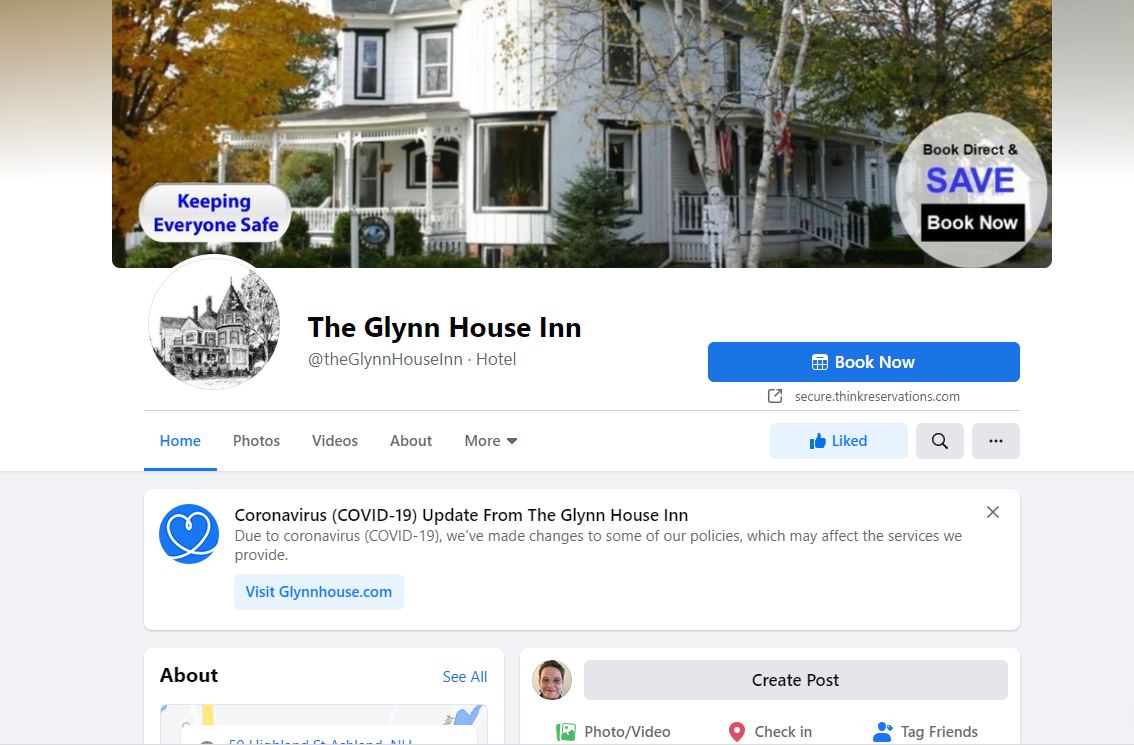
As usual Facebook when they add (or delete) things, they tend not to let users know. This is one that I suspect not a lot of business owners know about as I’ve only seen it so far on two business pages.
If you are advertising additional safety measures that your business is doing to help keep people safe you may want to consider enabling this option. I suspect we may see additional changes in the next several weeks to a month as since I had done a SCORE workshop on the new business format there have been over a dozen small page changes since then.
In order to get the banner, go to “Edit Page Info” (on the left) or on the left alignment in the body of the business page and then scroll down towards the bottom (in the middle) and you will see various options. I’d recommend not just sending people to your home page unless you are actually advertising the information on your home page but instead directing people to specifically where on your website that information is listed so you don’t make people hunt.
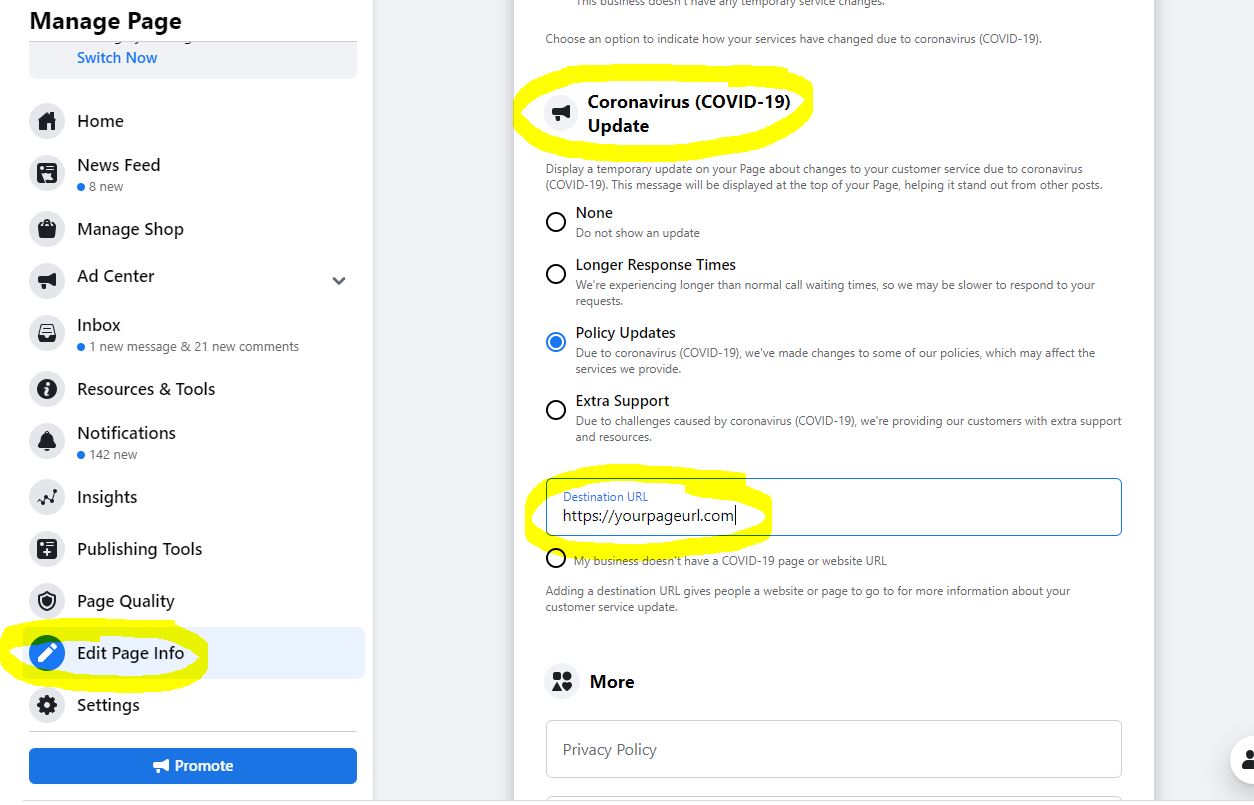
by Heather T. | Sep 30, 2020 | Bed and Breakfasts, Lodging, Marketing, Opinion
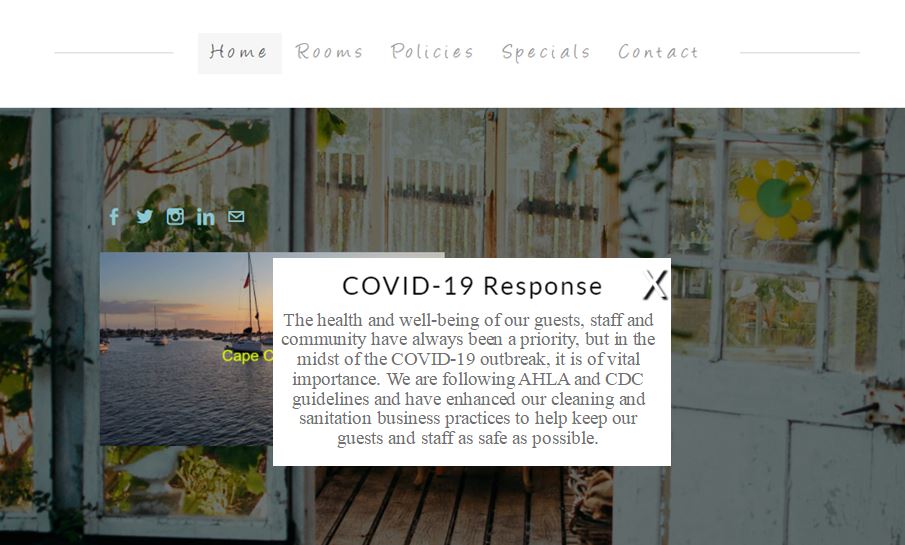
COVID is an issue with lodging, whether you believe it is a real threat or not. Studies by industry experts have shown that a large majority of people traveling take it seriously and are concerned for the cleanliness and sanitation of a facility.
Recent news highlights that many hotels and homestays as well are not paying attention to standards even though they tout they are.
Where does this leave other legal lodging properties?
It leaves us with a golden opportunity to capture the market of people who are leery of traveling and are very concerned for their safety. While most B&Bs and other lodging properties are making a point somewhere on their websites of mentioning what they are doing to keep guests safe, Some are not. That needs to be fixed, especially if your property is implementing additional safety standards. Your potential guests won’t take the time to inquire, they will just go elsewhere.
 I did want to point out some things I am seeing that can be improved and adjusted with many of the properties that ARE advertising what they are doing. One of the biggest pitfalls I am seeing is the use of pop-up boxes. Pop-up boxes are great, I love pop-ups, BUT not so great for advertising what you are doing for cleaning and safety standards if that is the ONLY place you are letting guests know about it. I am seeing a lot of properties have these boxes, but nowhere else on their site are they talking about the additional steps they are taking.
I did want to point out some things I am seeing that can be improved and adjusted with many of the properties that ARE advertising what they are doing. One of the biggest pitfalls I am seeing is the use of pop-up boxes. Pop-up boxes are great, I love pop-ups, BUT not so great for advertising what you are doing for cleaning and safety standards if that is the ONLY place you are letting guests know about it. I am seeing a lot of properties have these boxes, but nowhere else on their site are they talking about the additional steps they are taking.
As a guest, I may (or may not) bother to read the popup, once it’s closed, it’s gone. What if I have questions? What if I did want to now read it but now can’t do so because I’ve closed the pop-up? I am not going to search and I probably won’t bother to inquire, I’ll go elsewhere. I’d add the pop-up boxes that go on for over a page, the ones with the fancy script that’s impossible to read and the text that’s font size 6 where even with a magnifying glass it’s hard to read as ones that are not helping to properly let guests know what your property is doing. 2 out of every 3 properties with pop-ups only have the information on the pop-up. I’ve been tracking this as I look at dozens of property websites a week.
As a guest, and in normal times I am one frequently, I want to know what a property is doing to keep me safe. If I had to travel now, I would definitely stay in a B&B, with the caveat that I can find easily what the property is doing to keep me (and other guests, and themselves) as safe as possible.
While I do agree we don’t want to go overboard, think of how a guest or potential guest views your site to potentially make a reservation (looking at your Google Analytics would help as well), they land on your home page (and may not scroll down below the fold if that is where you have your safety information listed). Where else if anywhere is your safety information listed? Is it a separate page? Do people know to go there, ie is it under the same drop-down tab as your rooms? Does it have a brief mention on your rooms pages or your policies page or your reservations platform? Have you posted about it on Facebook or other social media? How many times? If it was only once, how about mentioning it every few weeks? Have you taken advantage of Tripadvisors ability to let guests know what you are doing additionally? What about Yelp? What about your Google My Business listings?
If your property is taking the extra time and added expense to enhance your cleaning and safety standards, please let your guests know about it. They want reassurance and you can advertise that you care, but you need to let them know you do in ways they will actually see and remember.
by Heather T. | Sep 22, 2020 | Food, Marketing, Operations, restaurants
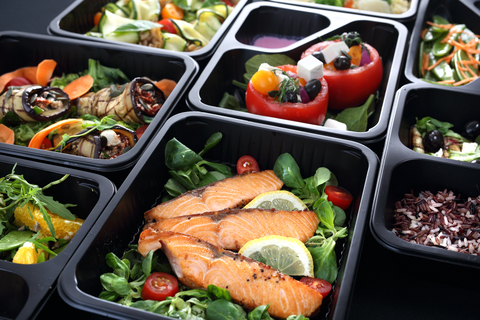 For at least the foreseeable future takeout is probably here to stay for a bit. Love it or hate it as a restaurant owner, having to accept the fact that it is a viable revenue stream is still tough for a lot of owners and managers to adjust to, especially for fine dining restaurants. But as the colder weather approaches it bears a lot of thought to re-address all aspects of takeout.
For at least the foreseeable future takeout is probably here to stay for a bit. Love it or hate it as a restaurant owner, having to accept the fact that it is a viable revenue stream is still tough for a lot of owners and managers to adjust to, especially for fine dining restaurants. But as the colder weather approaches it bears a lot of thought to re-address all aspects of takeout.
I’ve seen many restaurants trying to offer the same menus for in-person dining repurposed to do as takeout, unfortunately for many restaurants, that can be a fatal flaw. Not every menu item adjusts to the takeout scene well, in many cases, reheating it causes overcooking, dryness, or in the case of many fried or sauteed items (like a chicken Marsala with a chicken breast that has been egg and flour dipped and then sauced right before serving) ends up being soggy in transit and may not lend well to reheating.
I’ll be addressing doing a deep dive on the menu itself in the next blog but wanted to address some things regarding takeout containers first.
Questions to ask:
Does it reheat well? And specifically, have you as the Chef or management/owners tried to reheat it in a variety of ways? To take the chicken Marsala as a good example, microwaving the chicken will probably kill it (unless you like rubber chickens), and nuking the sauce will probably break it. Heavy cream doesn’t generally play nice with microwaves. A perfect reheat would probably be the chicken heated up separately in a hot oven with the sauce separate and reheated with the mushrooms in a saucepan and the sauce packed to go separately.
So…Do your customers know how to reheat your food? And if not, how would they know? And if you don’t want to bother considering that, is a rubber chicken with broken sauce doing your restaurant any favors as an example? The number of reviews I have seen since Covid hit mentioning that people were not very happy with their take out for restaurants with normally good to great reviews has not decreased much so it’s still apparently a big problem.
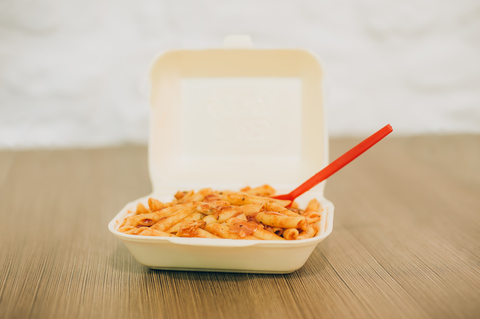 Next, Is it going to look attractive in the container? While some restaurants may not have the style of dining that plate presentation is high on the priority list, if you have a fine dining restaurant (for example) and you take pride in that, it is a consideration. While I have worked a variety of types of restaurants no matter the level of dining, plate presentation was always important to me, but in some cases, a takeout burger and waffle fries may not have a ton of ways to dress it up but even that can either look attractive when unboxed (or not). I am seeing a huge amount of takeout photos on Instagram and Facebook, so the love affair with taking food photos has not dimmed much. Does this container of pasta look ok? Or could a little garnish improve it? Not sure? Take a few photos with your smart phone yourself? Does it look attractive? Appealing? If you saw it posted on Instagram, would it make you want to get take out from your restaurant?
Next, Is it going to look attractive in the container? While some restaurants may not have the style of dining that plate presentation is high on the priority list, if you have a fine dining restaurant (for example) and you take pride in that, it is a consideration. While I have worked a variety of types of restaurants no matter the level of dining, plate presentation was always important to me, but in some cases, a takeout burger and waffle fries may not have a ton of ways to dress it up but even that can either look attractive when unboxed (or not). I am seeing a huge amount of takeout photos on Instagram and Facebook, so the love affair with taking food photos has not dimmed much. Does this container of pasta look ok? Or could a little garnish improve it? Not sure? Take a few photos with your smart phone yourself? Does it look attractive? Appealing? If you saw it posted on Instagram, would it make you want to get take out from your restaurant?
Are there reheating instructions? A medium-rare steak will not be MR when reheated improperly, does that reflect on the restaurant if customers overcook a dish at home? I would say yes because you can’t expect people to know.
Can customers reheat a dish directly in the container or does it need to be transferred? Is it easy to transfer? Is it messy? Do you loose sauce or ingredients in transferring?
Is the takeout container reusable? To use an example of why that may be a consideration: when we lived in CT, there were two oriental restaurants with similar pricing and fairly comparable food. We ordered from one because A. the containers were not flimsy, the other ones were and we gave up ordering food from them when we had a mess to clean up at home almost every time, and B. the containers were washable and reusable.
Is the takeout container cheap and flimsy? (see above) If you want to go for non-reusable/non-recyclable containers, is the container going to stand up to travel, being lifted out of a bag, and held with one hand (or will it take two and fold over spilling everything everywhere?). We have gotten take out from restaurants who use the round oval aluminum take out containers which while they are fine for light food like salads, load them up with a heavy entrée with sauce and the result can be a mess on the customers end. They might remember the food was good but they will also remember the hassle and inconvenience.
Does the container retain heat well? or remain cold? If I order takeout from a restaurant minutes away I expect the food to remain hot until I get home. And is it protected from anything that is not hot? Is there a layer of cardboard or another item in between. Is your staff giving attention to packing up take out so salads don’t end up directly above or below a hot item? Or cold desserts getting melted by being close to a hot item? Yum wilted warm salad. Delish!
Having a variety of containers on hand for different types of items are highly suggested. And add the price of takeout to your menus, it may only be 15-20 cents per but it can add up very fast if you don’t factor it in and it appears looking at a lot of menus from pre-Covid and current, many restaurants are not. It’s a small adjustment but worth it.
 Consider the Chinese takeout container, high sides, fairly heavy-duty, and well designed, there is a reason this design has been in use for a very long time. It also stacks well and that is an additional factor to think about when evaluating your takeout containers. I’m not saying every restaurant should use these, but merely to consider things that need to factor in choosing containers. Stackability, structure, and compact fit in a bag vs rounds or an assortment of different shaped oblongs. The vast variety of takeout containers available on the market offers a plethora of options, find what works for you instead of purely going by price or looks. The final result is the important part and again if a decent container that fits the bill is 5 cents more then the cheap round, buy it and add it to the menu price, your customers will thank you.
Consider the Chinese takeout container, high sides, fairly heavy-duty, and well designed, there is a reason this design has been in use for a very long time. It also stacks well and that is an additional factor to think about when evaluating your takeout containers. I’m not saying every restaurant should use these, but merely to consider things that need to factor in choosing containers. Stackability, structure, and compact fit in a bag vs rounds or an assortment of different shaped oblongs. The vast variety of takeout containers available on the market offers a plethora of options, find what works for you instead of purely going by price or looks. The final result is the important part and again if a decent container that fits the bill is 5 cents more then the cheap round, buy it and add it to the menu price, your customers will thank you.
by Heather T. | Jul 15, 2020 | Blog, Marketing, Operations
Virtual Booth Tradeshow Prep (prior to the virtual show)
 I had made up this checklist a while back as I’ve had a lot of people ask for advice and direction venturing into the new realm of doing virtual tradeshows. While there seems to be a ton of information out there about running and hosting a virtual tradeshow, I could not find much direction in terms of being a vendor and having a virtual tradeshow booth.
I had made up this checklist a while back as I’ve had a lot of people ask for advice and direction venturing into the new realm of doing virtual tradeshows. While there seems to be a ton of information out there about running and hosting a virtual tradeshow, I could not find much direction in terms of being a vendor and having a virtual tradeshow booth.
So I put together some thoughts based on doing webinars, Zoom meetings, participating in 4 virtual trade show events and attending since March over 100 virtual tradeshows as an attendee. Being an attendee was very helpful because I got to see some of the online glitches and errors that booth hosts could probably have avoided with a bit more prep in advance.
If you happen to come across any good articles on organizing and running a trade show booth and/or you’ve run or participated in one and have some additional suggestions or things you’ve come across, please leave them in the comments and I’ll add them (with Kudos and a track back to the submitter if you leave a helpful non-salesy comment (i.e. not buy my stuff as sales pitch).
- Familiarize yourself with the online virtual tradeshow format as far ahead in advance as the information is available to you.
- Google the format as well, find out if others have had trouble with the system prior so you are prepared in advance.
- Schedule a test run call with your booth co-hosts before your live event. (at least one call, if the booth co-host is having difficulties or seems very uncomfortable, make sure you schedule at least a second one closer to the event as well) (If applicable or the options are given do it on the platform, having a test run prior on Zoom or other online meeting if the platform is not yet available is suggested to at least do a run through in advance.)
- Add any polls ahead of time (choice of one choice, or multiple choice polls) ask the co-presenters in advance if they are going to run polls, and coordinate when during the booth virtual they will be run. Polls may not be available with all software (If applicable or the options are given) or if they are only available day of, prepare them in advance.
- Gather any online handouts and links ahead of time and pre-load them in or have them easily accessible to reference in a Google doc or other format.
- Clear your browser cache out prior (for reference: https://www.pcmag.com/how-to/how-to-clear-your-cache-on-any-browser or https://kb.iu.edu/d/ahic)
- Bring up any links you will referencing “live”, Proof the links in advance, nothing is more embarrassing then finding typos or wrong outdated information while you are doing a demo for booth attendees.
- Don’t depend on the internet, so if displaying things on web pages “live”, it is better to do screenshots and pull up the net “live” if there is time near the end of the session with an attendee or group of attendees. Or at least take screenshots and have a powerpoint ready to go for any displays or examples if the rest of the web is not cooperating.
- Prior to the booth session, turn off or unplug any phones including cell phones, neighboring computers you might get feedback from, and make sure your “space” to going to be quiet. Free the rooms from potentially barking dogs, kids, spouses, significant others and other distractions. Don’t have anything in the oven that can potentially set the smoke alarm off even if you have someone in the house, you can’t rely on them to take care of it.
- Start early before you go live to give yourself time to get logged into everything and quickly fix any issues or restart/reload any windows/applications, check video/sound, etc.) At least 15 minutes prior to the booth session, ½ hour is much better, make sure any booth co-hosts login in AT LEAST 15 minutes prior if not before, recommend ½ hour pre-login as well for yourself. Logging in right before the booth session starts, one almost always runs into a technical glitch.
- Make sure you have your introductions ready for yourself and any booth co-hosts and have rehearsed walking through it. Check for name pronunciations prior to the webinar if needed.
- Until you go “live” it may seem safe to discuss anything under the sun, but refrain from discussing anything confidential or personal, glitches do happen and you don’t know what is actually logged in the backend of a system you may be in.
- Have some general Q&A questions done up ahead of time to spark discussion and inspire booth visitors/attendees to ask questions. This is also helpful if you don’t have a huge attendance or people just can’t think of things to ask.
- Be connected to the Internet via Ethernet/Hardwired connection. Wireless connections will work, but your audio and video quality will suffer, and you may have playback issues if you are recording.
- If you plan to use music, videos, or images, remember to use only what you have permission to use. YouTube can and will remove all sound from a video with copyrighted music even if it’s in taped format if you are recording the session and have plans to use any part of it afterward for marketing.
- Have at least several glasses of room temperature water handy and remind your booth co-hosts to as well.
- Turn off any program or device that will compete for your bandwidth. This includes things like Google Drive and Dropbox that automatically update.
- Make sure any popups, ie. Anti-virus reminders, Windows updates are not going to pop up during your presentation, remind any booth co-hosts as well if they are screen sharing.
- Make sure Windows or OX is up to date prior to starting, preferably the day before. Having a computer decide to update or reboot mid-session can be a drastic interruption especially if you are the sole booth host.
- When screen sharing be aware that depending on the virtual tradeshow software used, generally everything can be seen, including bottom taskbars and if you are using the internet, bookmarks as well as open tabs on a browser. Remind the booth co-hosts of this as well.
- Recommend having two computers if you are the booth host, one to be the host, the other to be logged in as an attendee (make sure and mute the sound from this one). This helps for two reasons, one there is sometimes a small time lag, and if you are speaking you want to make sure any slides or anything online you are speaking to are consistent with what the other booth visitors/attendees are seeing.
- Be prepared for interruptions, door bells ringing, dogs barking, kids etc. If you have booth co-hosts, have a key word or phrase ready to let them know they need run point/take over for a few minutes until an issue is dealt with if needed.
- Be prepared for things NOT to work, the booth co-hosts can’t get on, they don’t have audio or visual, etc.
- Practice using the camera on your computer, phone or laptop. You can do this at any time prior to the booth session.
- Plan your lighting so that your face is well lit. Avoid sitting with your back to a window or other source of light and be aware that some overhead lighting can also make it difficult to see you clearly. Eye glasses tend to have a glare and if you tilt the back of the ear pieces up and the nose piece slight down it can reduce direct glare.
- Position yourself so that your upper body is visible, not just your face. This will allow you to be more expressive when speaking and people can see hand gestures and movements.
- If you are using a phone or tablet, ensure that it is placed on a stable surface.
- Ideally, position the camera so that it is at eye level when you are looking forward. This makes for better “eye contact” with the viewers. If you are using a laptop, consider putting it on top of some books or other platform so it brings the webcam up to eye level.
- When speaking, make “eye contact” by looking directly at the camera lens. This can feel uncomfortable at first and takes practice, but it makes a significant difference to the effectiveness of your online communication.
- Wear a headset if possible, it cuts down on external noise and audio and mics are easier to hear and have a better sound quality then having someone call in on their phone.
- Virtual backgrounds are fun but also suck up bandwidth, consider having some sort of backdrop especially if the room you are in is “busy”, Even a bed sheet hung up works well. If your business has a pop up display for in person tradeshows this can also be used as a partial background. Table coverings with branded logos make an excellent background if they are available (for use in in person tradeshows)
- Remember to use the “mute” feature when you are not speaking to eliminate background sounds, and be aware of where it is at all times in case you have an unexpected distraction/interruption.
- Wear muted and solid colors, patterns/stripes/busy patterns are very distracting. No hats, suggested jewelry is small and not shiny (shiny jewelry reflects computer light and can be distracting if it flashes when you move, not just earrings but watches, and large rings as well)
- Be cognizant of your facial expressions on camera, touching your hair and face is common but can also be a distraction to the booth visitors/attendees. If you use hand movements while you talk to describe something, be aware that your gestures need to be seen in the frame of the camera.
Some additional questions to ask yourself prior to the virtual tradeshow:
- How are you going to capture information?
- How are you going to follow up?
- Is your virtual booth going to have demos (demonstrations) at set times or ongoing ones or is going to be a general Q&A or will there people on hand to break off for one on one discussions (if the platform allows).
Some additional Prep:
- Have logos and photos available in different resolutions/sizes and formats in advance.
- Check any links you will be submitting to use for advertising on the host/virtual show site, check for updates/typos and out of date information.
- Have head shots prepared (not all virtual tradeshows offer this option but many do) and available in different resolutions/sizes to use as needed.
Some questions after the fact to ask yourself after the virtual tradeshow:
- If the virtual tradeshow had a cost, did you make your money back or is there a good chance you will?
- Was the time spent preparing and running the virtual booth worthwhile? This is not necessarily the same question as did you make or potentially make a profit from it.
- What could you do better or differently if you did it again?
by Heather T. | Apr 28, 2020 | Bed and Breakfasts, Marketing, Opinion, Social Media
 If you just want the Instagram hack, skip to the bottom links 🙂
If you just want the Instagram hack, skip to the bottom links 🙂
I’ll be the first one to admit, I’m not terribly fond of Instagram, one of the primary reasons being it’s smartphone-based, and I really don’t like my cell phone much.
To me it’s useful, it’s a tool I use for taking bad pictures (an iPhone 6 doesn’t take the best photos), getting texts from family and a few friends (mostly because I don’t give the number out much) and to check email in a pinch. Oh and I also use it a lot for Google maps and navigation.
What I don’t want is to be tied to it 24/7 like so many of my friends and family are, checking the damn thing several dozen times per hour. I am already on a computer working 12+ hours a day usually. Downtime is a good book, not checking Pinterest boards or scrolling through social media feeds.
One of the other reasons I am not fond of Instagram and this from a purely marketing perspective as well as a time perspective, is most of the photos I have are desktop-based or I take photos with a digital SLR camera, which I love, and so most photos end up on my main computer. To post anything to Instagram by smartphone I would have to transfer them by connector cord or digitally and that seems like a waste of time, add in the fact that I have a million thumbs and it takes me 5 minutes to type in a text message in the first place, Instagram is not my fave rave.
About a year and half ago I came across a blog post talking about using Instagram from the web and was overjoyed, a way around having to post by phone! The hack was only for Google Chrome and I’ve been showing other people how to do it since then. It came up recently asking if I knew if you could post via computer with other browsers and I was not aware of how to but supposed you probably could.
With that in mind. I messed around online a bit and I found you can post with Firefox and Microsoft Edge. I would imagine you can with a Mac, but I don’t have one to test it on but did find this, if this is current enough and works, if anyone tries it please let me know. https://www.howtogeek.com/howto/12663/view-mobile-websites-in-windows-with-safari-4-developer-tools/ . I did not try it on Microsoft Explorer because quite frankly Explorer is not the safest browser and if you are still using it I’d encourage a switch to pretty much any other one out there.
Using Instagram from the web does have downsides, you can’t post videos, you can’t save drafts and you don’t have access to many of the bell and whistle options in the back-end of mobile-based Instagram and you can’t run ads on it unless you are doing it connected to Facebook. The plus side is you can set up an Instagram account this way, set up your profile, add a profile picture, follow people, comment and like posts and direct message people, PLUS you can post pictures directly to Instagram from a desktop/laptop-based browser.
If you do want some options for scheduling Instagram posts and keep in mind I get biased by price (I prefer free) but I also don’t like software that glitches easily or often or customer support that is non-existent or takes forever to get back to you (Hello Facebook!). So with that in mind……
Buffer (Free and Paid)-I LOVE Buffer
Later (Free and Paid)-tried it more than a few times, glitched quite a bit
Hootsuite (Free and Paid)-tried it more than a few times, glitched quite a bit and I find the interface not the friendliest
Tailwind (Paid)-very good for Instagram and Pinterest
Posting cheat sheets in PDF:
Instagram from a web browser in Firefox
Instagram from a web browser in Google Chrome
Instagram from a web browser in Microsoft Edge
Have fun! And if you are a Bed and Breakfast reading this, don’t forget you can participate in the ALP Better Way to Stay Get Heads In Beds Initiative starting May 1, 2020. More information at https://betterwaytostay.com/campaign/
by Heather T. | Apr 14, 2020 | Bed and Breakfasts, Blog, Lodging, Marketing, Social Media
 So I think I’ve sent these links out including the post ideas several hundred times within the last few weeks so thought if anyone else might find them useful, have at it. 🙂
So I think I’ve sent these links out including the post ideas several hundred times within the last few weeks so thought if anyone else might find them useful, have at it. 🙂
Resource Links for Social Media and other online tools I use quite a bit:
Canva
Youtube
Pinterest
Instagram
Twitter
Facebook
Linkedin
Google Docs & Spreadsheets Tutorials
To reduce Image File Size
Remove Image Background
CloudConvert File Converter
Free PDF editor & form filler (use the free online version)
Stock Photo Information
Model Releases (for adults and children)
25 Blogging ideas for Inns and B&B’s (also useful for things to tweet about or blog about or use for other social media) plus more underneath crisis related as hard sell advertising is not recommended right now.
- Recipes: recipes you use, recipes you’ve come across that sounded good that the inn is going to try at some point, recipes given to you by guests or friends (including other innkeepers).*caveat: No poaching of Google images, take the photos yourself or buy from a stock photo source or guests may have pictures to share with you (always credit them) Good images can be obtained for around a buck from stock photo sources. If the recipe is something you serve on a regular basis, highly recommended you take an actual photo or use stock that comes very very close to the real thing. I hope I don’t have to explain why ?
- Recipe failures with a funny story.
- Guest Comments.
- Your Inn in the News.
- Area attractions in the news.
- A frequent and Loyal Guest in the News.
- Specials and Packages at your inn. (wait until things are closer to opening up, but mention them as reminders)
- Area Attractions with contact information about the attraction, a weblink, directions and why its interesting.
- Area attractions reviews (including dining).*caveat: especially if its dining, make sure it’s a review that a recent guest or guests had and not your personal point of view, i.e. don’t piss off the locals that might refer you.
- Trip Itineraries for Guests, make a custom Google map pined with locations (this is free by the way and easy to use)
- Pictures of the inn: if it’s food give a title to it if it’s not accompanied by a recipe, if it’s a particular location in or around the inn, describe it.
- Pictures of happy guests, with their permission and preferably in writing. Customizable Model Releases in MS word. (link below)
- Area Events going on, you can also tie this into area restaurants having specialty diners or wine tastings.
- A brief, “we get frequent questions “about” and put in answers.
- What does your inn do to differentiate itself from the others.
- You just found a new product you are using it and love, be it food or a new fabric softener, describe it and explain why you love it.
- Funny guest stories. *caveat: make them funny and only funny, proof heavily to make sure they are not negative in any way. While a wife may go into the wrong room by mistake in the middle of the night may have very amusing consequences, it raises things like don’t they have locks on the doors? (even if you do and point out they didn’t lock them) etc. etc.
- Do some food specific reviews. You have a couple of apple orchards nearby. Do some write-ups on the apples, do some research on types of apples, link to sources.
- Research and write about area birds that come to and hang around the inns, pictures are always a plus.
- Research and do some write-ups about the area plants and trees in the area. You have a historic stand of black birches in the area, some history, background (and pictures) you grow opal basil in your inn garden, tie it into some recipes you use and write about the difference in taste and appearance between that and regular basil.
- Ask for feedback, from blog readers and from prior guests. You just went from goose down pillows to memory foam pillows. Ask for some thoughts from people; don’t forget to include the link to this blog article when you do your next email blast.
- A bio of yourselves and/or your staff.
- A book review or commentary about a local author.
- Suggestions for weather/time of year guests. i.e. August is prime season for ticks in New England, add tick repellent tips, wear white, use a good repellent (which we also keep extra of the at inn by the way) etc. etc. On hot muggy days our guests like to go to a cool shaded out of the way place to dip and bring a picnic (provided by the inn as an amenity of course).
- Targeted things to do, coming with an elder relative, they might like…. Coming with young children, they might like….Bringing your dog, you and your pup might like……
Originally on: 25 Blogging Ideas for Inns and B&Bs (and other posting channels)
Some Additional ones from recent blog posts (Covid Crisis)
- What you are doing or going to do in the community to help.
- Testimonials and reviews from past guests.
- Recipes you make normally (with lots of pictures) tie some quotes from past reviews in there too.
- If you are learning a new skill or more “about “something (highly recommended) write about it!
- Tips on recipes substitutions and also cooking recipes or tips that people can do with limited ingredients.
- Local news (and other news) of people reaching out and doing something nice for others. Everyone needs the positive right now.
- Photos of things in the inn, not necessarily rooms, but closeups and write a story about them.
- Photos of outside the inn, wide shots and closeups too, as Spring comes, flowers and other plants are going to be coming up and blooming, sharing beauty is always a positive. People need it and will continue to need it.
- Test recipes (if you are going to or can play with new ones) ask for feedback on posts, what do people think? Or just post the link and add some text.
- Do online cooking tutorials or demonstrations. Live stream it if you are up for it.
- Other skills or other hobbies you can share online
- If you have dogs or cats (or other animals) at your inn and you are not already using them for marketing, now is the time.
- Talk about some of the things you have in the inn and WHY you like them and use them.
Originally on Working towards future heads in beds and Restore, Engage, Aggregate, De-stress and You for Innkeepers
And ALP (Association of Lodging Professionals) will have something hopefully useful to help Innkeepers, stay tuned for an announcement on Wednesday afternoon……..




 I did want to point out some things I am seeing that can be improved and adjusted with many of the properties that ARE advertising what they are doing. One of the biggest pitfalls I am seeing is the use of pop-up boxes. Pop-up boxes are great, I love pop-ups, BUT not so great for advertising what you are doing for cleaning and safety standards if that is the ONLY place you are letting guests know about it. I am seeing a lot of properties have these boxes, but nowhere else on their site are they talking about the additional steps they are taking.
I did want to point out some things I am seeing that can be improved and adjusted with many of the properties that ARE advertising what they are doing. One of the biggest pitfalls I am seeing is the use of pop-up boxes. Pop-up boxes are great, I love pop-ups, BUT not so great for advertising what you are doing for cleaning and safety standards if that is the ONLY place you are letting guests know about it. I am seeing a lot of properties have these boxes, but nowhere else on their site are they talking about the additional steps they are taking. For at least the foreseeable future takeout is probably here to stay for a bit. Love it or hate it as a restaurant owner, having to accept the fact that it is a viable revenue stream is still tough for a lot of owners and managers to adjust to, especially for fine dining restaurants. But as the colder weather approaches it bears a lot of thought to re-address all aspects of takeout.
For at least the foreseeable future takeout is probably here to stay for a bit. Love it or hate it as a restaurant owner, having to accept the fact that it is a viable revenue stream is still tough for a lot of owners and managers to adjust to, especially for fine dining restaurants. But as the colder weather approaches it bears a lot of thought to re-address all aspects of takeout. Next, Is it going to look attractive in the container? While some restaurants may not have the style of dining that plate presentation is high on the priority list, if you have a fine dining restaurant (for example) and you take pride in that, it is a consideration. While I have worked a variety of types of restaurants no matter the level of dining, plate presentation was always important to me, but in some cases, a takeout burger and waffle fries may not have a ton of ways to dress it up but even that can either look attractive when unboxed (or not). I am seeing a huge amount of takeout photos on Instagram and Facebook, so the love affair with taking food photos has not dimmed much. Does this container of pasta look ok? Or could a little garnish improve it? Not sure? Take a few photos with your smart phone yourself? Does it look attractive? Appealing? If you saw it posted on Instagram, would it make you want to get take out from your restaurant?
Next, Is it going to look attractive in the container? While some restaurants may not have the style of dining that plate presentation is high on the priority list, if you have a fine dining restaurant (for example) and you take pride in that, it is a consideration. While I have worked a variety of types of restaurants no matter the level of dining, plate presentation was always important to me, but in some cases, a takeout burger and waffle fries may not have a ton of ways to dress it up but even that can either look attractive when unboxed (or not). I am seeing a huge amount of takeout photos on Instagram and Facebook, so the love affair with taking food photos has not dimmed much. Does this container of pasta look ok? Or could a little garnish improve it? Not sure? Take a few photos with your smart phone yourself? Does it look attractive? Appealing? If you saw it posted on Instagram, would it make you want to get take out from your restaurant?  Consider the Chinese takeout container, high sides, fairly heavy-duty, and well designed, there is a reason this design has been in use for a very long time. It also stacks well and that is an additional factor to think about when evaluating your takeout containers. I’m not saying every restaurant should use these, but merely to consider things that need to factor in choosing containers. Stackability, structure, and compact fit in a bag vs rounds or an assortment of different shaped oblongs. The vast variety of takeout containers available on the market offers a plethora of options, find what works for you instead of purely going by price or looks. The final result is the important part and again if a decent container that fits the bill is 5 cents more then the cheap round, buy it and add it to the menu price, your customers will thank you.
Consider the Chinese takeout container, high sides, fairly heavy-duty, and well designed, there is a reason this design has been in use for a very long time. It also stacks well and that is an additional factor to think about when evaluating your takeout containers. I’m not saying every restaurant should use these, but merely to consider things that need to factor in choosing containers. Stackability, structure, and compact fit in a bag vs rounds or an assortment of different shaped oblongs. The vast variety of takeout containers available on the market offers a plethora of options, find what works for you instead of purely going by price or looks. The final result is the important part and again if a decent container that fits the bill is 5 cents more then the cheap round, buy it and add it to the menu price, your customers will thank you. I had made up this checklist a while back as I’ve had a lot of people ask for advice and direction venturing into the new realm of doing virtual tradeshows. While there seems to be a ton of information out there about running and hosting a virtual tradeshow, I could not find much direction in terms of being a vendor and having a virtual tradeshow booth.
I had made up this checklist a while back as I’ve had a lot of people ask for advice and direction venturing into the new realm of doing virtual tradeshows. While there seems to be a ton of information out there about running and hosting a virtual tradeshow, I could not find much direction in terms of being a vendor and having a virtual tradeshow booth. If you just want the Instagram hack, skip to the bottom links 🙂
If you just want the Instagram hack, skip to the bottom links 🙂 So I think I’ve sent these links out including the post ideas several hundred times within the last few weeks so thought if anyone else might find them useful, have at it. 🙂
So I think I’ve sent these links out including the post ideas several hundred times within the last few weeks so thought if anyone else might find them useful, have at it. 🙂